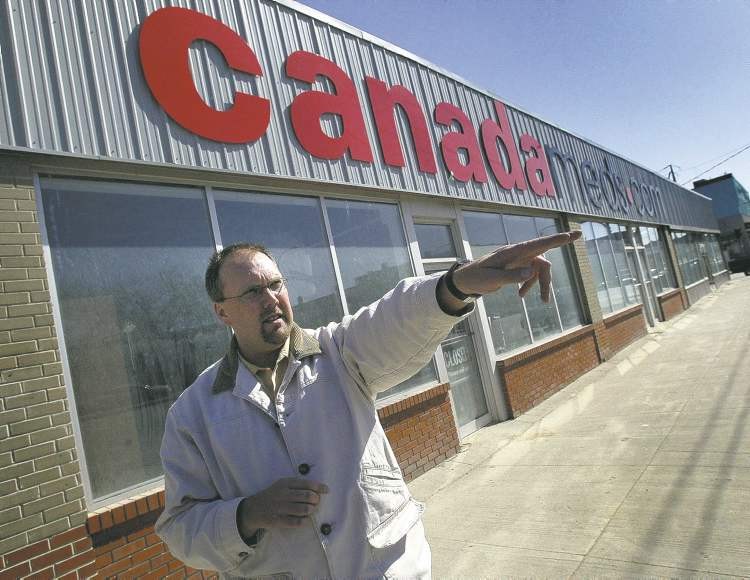A crack in the vault Winnipeg Free Press
Post on: 24 Апрель, 2015 No Comment

CDIC wants Canadians to know their bank accounts are safe, but assurances have their limits
Quick facts
What about credit unions? Credit unions are provincially regulated financial institutions. Each province creates its own legislation and accompanying regulating body to ensure credit union members’ deposits are protected. In Manitoba, the Deposit Guarantee Corporation of Manitoba (DGCM) insures deposits such as GICs, savings and chequing accounts. Unlike the CDIC (Canada Deposit Insurance Corp.), the corporation places no limits on insuring deposits. About $20 billion in deposits are insured in Manitoba, says its CEO, Vernon MacNeill. We have a little over $200 million in our fund right now, and as a rule of thumb as an insurer, you should have one per cent of insurable deposits. The DGCM would handle a credit union failure much the same way the CDIC would handle a bank failure, he says. If there was ever a problem, we could amalgamate a failing credit union with a stronger entity, but right now, Manitoba credit unions are in very good shape. He says the credit union deposit insurer is also different from the CDIC in that it’s a regulator, much as the federal OSFI (Office of the Superintendent of Financial Institutions) is for banks and other financial institutions across Canada. If we see where a credit union is failing with its own reserve capital that is causing any concern to us, then we would step in and have them change what’s required, he says. If they couldn’t do that, then we would also put them under our supervision and amalgamate them with a stronger entity or whatever the required measures would be. If no suitor can be found, the DGCM would use its assets to make depositors’ accounts whole.
But what if the losses are more than its assets in reserve? Would the province be on the hook? Here’s the province’s take on it, MacNeill says. The province has no legal liability to backstop us. However, if there was some sort of need for them to do it and we went to them to ask them to do it, the province would likely come to the table.
What’s not covered by deposit insurance? Anything invested in the markets isn’t covered by the CDIC or its credit-union counterpart, the DGCM. These would include stocks, bonds, options and mutual funds, for example. But these investments do come with their own form of insurance in the event an investment company holding your investments is insolvent. But to be clear, coverage does not apply to losses incurred as a result of the investments themselves. So if you buy $100,000 worth of company X stock and its price plunges to near zero, that’s your problem, not the insurer’s.
For mutual-fund investors, the Mutual Fund Dealers Association of Canada’s Investor Protection Corp. provides coverage up to $1 million aggregate per account, and like the CDIC, the limit will apply individually for RRSPs, RRIFs, TFSAs, trusts and similar accounts.
For investors in stocks and bonds, the Canadian Investor Protection Fund provides up to $1 million in coverage in aggregate.
Your money is safe.
That’s the message from the head of our nation’s guarantor of bank deposits.
It is a point that Michele Bourque, CEO and president of the Canada Deposit Insurance Corp. (CDIC) has been repeatedly hammering home to Canadians of late.
It was certainly the focus of the Crown corporation’s annual public meeting earlier this month in Saskatoon, where Bourque spoke to members of Advocis.
The CDIC recently partnered with the largest organization of financial advisers in Canada to promote awareness among Canadians of the CDIC’s evolving role in maintaining stability in the banking sector.
Her motive hasn’t been the result of a recent banking failure or a run on the bank — the two main reasons the CDIC was created in 1967.
Instead, it’s simply that many Canadians don’t know what exactly the CDIC does.
There’s a lot of work to be done to let Canadians know about the limits of our coverage so that they know how they can best protect their savings against the failure of one of our members, because it does happen, Bourque says.
As it turns out, only 60 per cent of Canadians are aware of the CDIC’s existence, and only about 30 per cent know it insures up to $100,000 in deposits.
What most people also don’t know is an individual’s deposits — savings and chequing accounts, GICs and term deposits of five years or less — are covered in aggregate up to $100,000 at each institution where they exist.
On the other hand, RRSPs, RRIFs, TFSAs, joint accounts and those held in trust are all insured separately, not in aggregate.
So at one institution, you could have multiple accounts that are insured separately up to $100,000, Bourque says.
Although a bank failure in Canada is rare, the CDIC has stepped in to secure depositors’ money 43 times in its 45-year history. The last time was in 1996, when the Security Home Mortgage Corp. failed.
The CDIC’s more than 80 members — banks, trust and loan companies and associations regulated under the Co-operative Credit Associations Act — pay a premium that’s invested to provide coverage in the event of a failure.
We insured as of April 30, when we take a pulse of our exposure, $645 billion, Bourque says.
More than anything, the CDIC’s role — along with the federal Finance Department, the Bank of Canada and the Office of the Superintendent of Financial Institutions of Canada (OSFI) — is to promote banking stability and consumer confidence.
When it comes to the health of the banking sector, confidence is everything. Banks take our dollars and lend them several times over.
A dollar gets deposited and the bank pays the depositor a tiny bit of interest. The bank lends most of that dollar, keeping a little in reserve, at a higher interest rate. The difference between the two interest rates is the bank’s profit. The money may be loaned to someone who buys a car, and eventually a portion of that original loaned dollar may get deposited in another account at the same bank and it’s loaned again. This process happens over and over, and it doesn’t just lubricate the gears of the economy. Through lending, banks create growth.
So the role of the CDIC isn’t just to insure our deposits, Bourque says; it’s also to assure us our money is safe. Because if we feel it’s not, everyone will want to withdraw their money and put it under the mattress. That’s how bank runs start. Everyone comes for their money at once, and the bank can’t meet all those obligations. It either shuts its doors or faces insolvency.
Yet bank runs, such as the one depicted in Frank Capra’s classic film It’s a Wonderful Life, aren’t what they used to be.
These days, bank failures have a lot more to do with missteps by the financial institutions themselves. They may be over-leveraged because they’ve lent their depositors’ dollars out not just one too many times, but several times beyond what’s considered reasonable. Then somewhere along the way, depositors’ dollars are lost on bad loans. Even worse, multibillion-dollar bets can be made and lost by rogue traders who have nothing to do with average depositors — except for the fact the bad bet somehow cost them their money.
This happened when Lehman Brothers, Bear Stearns and Merrill Lynch failed in 2008 because of their exposure to the U.S. subprime housing market. As U.S. investment banks, they didn’t directly lose depositors’ money, so their losses were not covered by the American version of the CDIC, the Federal Deposit Insurance Corp. (FDIC).
Yet many small U.S. retail banks covered by the FDIC went under as a result of their giant Wall Street counterparts’ activities.

Hundreds have filed for bankruptcy or been acquired by another bank in the last four years in order to avoid insolvency.
It wasn’t necessarily because of Lehman Brothers’ collapse, but more of a knock-on effect as a result of the housing market collapsing too, Bourque says.
Meanwhile, Canada’s banking system has been lauded as the most stable in the world, and Bourque says the federal government has made changes at the CDIC to help maintain that stability, including increased powers to keep a failing bank afloat until one on firmer financial ground can take it over.
When no other bank can step up, the CDIC must do so and use its assets to help make depositors’ eligible accounts whole.
The CDIC’s available assets to cover depositor losses are about $2.4 billion, or about 0.4 per cent of the total assets it insures. It’s in the process of increasing its assets to one per cent of all insurable deposits.
Yet in the highly unlikely event of the failure of one of our Big Five banks, which together have 76 per cent of all insured deposits, it appears the CDIC’s assets would fall far short.
Bourque says that’s why the federal government increased the CDIC’s line of credit over the last few years from $6 billion to $18 billion, and it can borrow more if needed.
If there was a failure tomorrow, we could borrow from the government, and we collect premiums and have a fund to pay back the government with interest, she says. Any cost, at the end of the day, is borne by industry.
Still, one might ask: What happens if more than one bank fails?
All at once — oh my! she says. Deposit insurance is not designed to save a whole crumbling system.
In that case, like our neighbours to the south, it would likely be left to the government — we taxpayers — to bail out the banks. Or we could let them fail, and millions of depositors would be left with nothing through no fault of their own.
So let’s hope our rock-solid pillars of finance are as fortified as advertised, because our world-leading banks are too big too fail.
And they’re far too big for the little CDIC to bail out their depositors all on its own.
giganticsmile@gmail.com
Republished from the Winnipeg Free Press print edition October 27, 2012 B12














